Caution: The following material is for informational purposes only, and is not intended to provide, and should not be relied on for, financial advice. You should consult your own financial advisors before engaging.
Satoshi Nakamoto is the pseudonym used by the mysterious person or persons who designed Bitcoin and created its original reference application and blockchain database. Nobody seems to know (or say) who Satoshi is or where he/she/they resided in October 2008 when the Bitcoin White Paper was first published. This White Paper is the authoritative systems design description giving all the necessary information along with a proposal for a “Peer-to-Peer Electronic Cash System”, which later became widely known as Bitcoin!
“Journalists…spent years looking for Nakamoto. His identity was one of the great mysteries of the Internet, and a holy grail of investigative reporting, with writers who couldn’t dig up evidence simply growing their own.” O’Hagan, Andrew. (2017) The Secret Life (p. 120). NY: Farrar, Straus and Giroux.
I myself have spent numerous maddening months researching in great detail any and all of the great variety of individuals, groups, or organizations suspected of being the real Satoshi Nakamoto, including Uncle Sam (the National Security Agency-NSA or the Central Intelligence Agency-CIA); Craig S. Wright and his partner Dave Kleiman; Elon Musk; Nick Szabo; Michael Clear, Donal O’Mahony, Michael Peirce, and Hitesh Tewari (Crypto Mano Group); Wei Dai; Hal Finney; Adam Back; David Chaum; Martti Malmi; Shinichi Mochizuki; Margaret Runchey; John Nash; Jed McCaleb; Tatsuaki Okamoto, Neal King, and Charles Bry; Vili Lehdonvirta; or Samsung-ToshiIba-Nakamichi-Motorola. It could be any one of them, or several of them, or someone else we don’t know about.
I have been passionate about finding out the real identity of Satoshi because I wanted to create an accurate astrological birth chart for Bitcoin. I don’t agree with what is widely being used by astrologers for the birth of Bitcoin on January 3, 2009 at 18:15:05 UTC when the first block in the Bitcoin blockchain was created. This is known as the Bitcoin Genesis Block. Undoubtedly, the birth of Bitcoin occurred before that, and more specifically, when Satoshi Nakamoto released his now-legendary White Paper. To cast an accurate birth chart, we need an exact date, time, and geographical location. We have the date and time for the White Paper, but the location is problematic.
According to the Cryptography Mailing List Archives, Satoshi’s email with the White Paper attachment was sent and received Friday, Oct 31, 2008 at 14:10:00 EDT in New York. However the mailing list is moderated, so the email may not have been received by everyone on the list until a day later on November 1, and the first response to the email was not sent until November 2. That said, I am using the aforesaid October 31 date and time for the birth of Bitcoin. The problem remains that we still don’t know who Satoshi Nakamoto is, and as such, we don’t know where Satoshi was when the paper was uploaded to the Cryptography Mailing List.
Part of my search took me into the intriguing world of Cypherpunks. I have come to believe that in order to understand the deeper origins and nature of Satoshi and Bitcoin, we need to look toward this group because Satoshi built on many of their existing ideas. Several of the individuals enumerated above in the list of “possible Satoshis” are part of this group. The name “Cypherpunks” was lightheartedly derived from a combination of cipher (a private or secret code) and Cyberpunks. The latter is a futuristic genre of science fiction featuring an alliance of social and political revolutionaries who are also innovators in science and technology. Cypherpunks are a group of activists who over the past several decades have been supporting the widespread use of cryptography and privacy-enhancing technologies as a path to cultural transformation.
“Privacy is necessary for an open society in the electronic age. Privacy is not secrecy. A private matter is something one doesn’t want the whole world to know, but a secret matter is something one doesn’t want anybody to know. Privacy is the power to selectively reveal oneself to the world…privacy in an open society requires anonymous transaction systems. Until now, cash has been the primary such system. An anonymous transaction system is not a secret transaction system. An anonymous system empowers individuals to reveal their identity when desired and only when desired; this is the essence of privacy. Privacy in an open society also requires cryptography. If I say something, I want it heard only by those for whom I intend it. If the content of my speech is available to the world, I have no privacy. To encrypt is to indicate the desire for privacy, and to encrypt with weak cryptography is to indicate not too much desire for privacy. Furthermore, to reveal one’s identity with assurance when the default is anonymity requires the cryptographic signature.” Cypherpunk Manifesto
Satoshi Nakamoto himself has often been called the ultimate Cipher or Cypherpunk. His original Bitcoin Genesis block actually contains an embedded message from The Times which seems to be an allusion to the group’s revolutionary ideology. The message that was embedded from the newspaper states: “Chancellor on Brink of Second Bailout for Banks.” This was a timestamp to substantiate that this Genesis Block was mined at this time and no other. It was also a cryptic message suggesting that Bitcoin’s decentralized global banking platform was forged to take down the corrupt and outmoded worldwide central banking cabal.
 Before Bitcoin’s debut, there was no record of Satoshi Nakamoto, and his emails and website addresses have been nearly untraceable because he apparently used anonymous e-mail servers and Tor (a software for enabling anonymous communication), and ostensibly didn’t disclose personal information online. It is also possible that he may have used Virtual Private Networks (VPS) to disguise his origin. He authored hundreds of posts in 2009 and 2010, and encouraged other software developers to work on and contribute to improving the original code. In April 2011, he sent a note to a fellow Bitcoin developer saying he’d moved onto other things, and then Satoshi pretty much disappeared.
Before Bitcoin’s debut, there was no record of Satoshi Nakamoto, and his emails and website addresses have been nearly untraceable because he apparently used anonymous e-mail servers and Tor (a software for enabling anonymous communication), and ostensibly didn’t disclose personal information online. It is also possible that he may have used Virtual Private Networks (VPS) to disguise his origin. He authored hundreds of posts in 2009 and 2010, and encouraged other software developers to work on and contribute to improving the original code. In April 2011, he sent a note to a fellow Bitcoin developer saying he’d moved onto other things, and then Satoshi pretty much disappeared.
None of the individuals, groups, or organizations suspected of being Satoshi has ever been completely verified. One of the explanations for this mystery was suggested by Craig S. Wright, one of the conceivable though as yet unconfirmed Satoshis. When Wright was posing as Satoshi a few years ago, he and his wife stated they were afraid that if he were proven to be Satoshi, he would be arrested by government authorities under the Terrorism Act, because Bitcoin had been used by terrorists to buy weapons.
Another explanation for Satoshi’s anonymity is that among those in the privacy-protection business of the Cypherpunk community, an anonymous person (“ghost”) is trusted much more than a named person. This goes along with the idea that the inventor of a decentralized program should remain unidentified so that the program then belongs to the whole community, as in the slogan that “We are all Satoshi.” There is a reference to this very idea in a short message posted on the Bitcoin developer forum at the Linux Foundation website in late 2015. This appeared after Craig Wright had been “outed” as Satoshi. It was titled “Not this again,” and was presumably posted by Satoshi though nobody knows if it was Satoshi or not. It stated, “I am not Craig Wright. We are all Satoshi.”
It’s rumored that America’s NSA (National Security Agency) and DHA (Department of Homeland Security) certainly do know of Satoshi’s true identity. The story goes that the NSA used “stylometry” (statistical analysis of variations in literary style between one writer or genre and another) to analyze emails and texts collected from their mass surveillance efforts, and from all this they were able to “place trillions of writings from more than a billion people in the same plane as Satoshi’s writings to find his true identity. The effort took less than a month and resulted in positive match.”
No matter who Satoshi is, whether an anarchist; a humble programmer or software engineer; a cryptologist; a secret agency like the NSA; a form of artificial intelligence (AI) or an ET as some far-out theories suggest; a corporate entity; a group of philanthropic researchers; an uber-wealthy inventor; the truth is that Bitcoin and the blockchain represent an amazing technology which will change the world.
As I was trying to determine the correct birth chart for Bitcoin, I cast several potential horoscopes for the Genesis Block and the Bitcoin White Paper. In an accurate horoscope, the ascendant (rising sign or lagna) of the chart needs to plainly describe the entity or individual that the chart represents. The ascendant is the macrocosm and has enormous significance in a birth chart. It is the filter through which everything else in the horoscope is expressed. It is the most personalized and essential element of the horoscope. I did my search with the intention that the ascendant for the Bitcoin chart must describe Bitcoin, so this was a pretty simple though quite time-consuming process for me.
I feel there is a strong possibility that Bitcoin originated in Van Nuys, CA. This is partly based on something I discovered on a website called https://whoissatoshi.wordpress.com/.The blogger of this site is called “Bounty Hunter” and is self-described as an “OSINT researcher and Bitcoin enthusiast.” OSINT refers to “open-source intelligence” which is part of the investigative process used when looking into online public intelligence to acquire information about an individual or entity. According to Bounty Hunter, “Communications in January 2009 between Satoshi and Hal Finney were traced and the IP address used by Satoshi was from Van Nuys, CA. This is not a TOR exit node which implies that this is the IP address used by Satoshi…”
Based on Bounty Hunter’s findings along with all my other investigations, I have a strong hunch that Satoshi is/was from Van Nuys and LA, or at least was there when Bitcoin was created. And if Satoshi was not there, at least his IP address was, which also means something. My astrological charts for Van Nuys similarly convey this theory. Here are some of the charts I examined (Please Note: all astrological charts are calculated according to the sidereal [not tropical] zodiac, and Lahiri ayanamsha):
1. Bitcoin Genesis Block January 3, 2009 at 18:15:05 UTC in London, England: This is one of the most commonly used birth charts for Bitcoin. Some use Dublin, Ireland instead which is very similar. The ascendant is sidereal Cancer which is a sign in mundane astrology that rules land, crops, food services, fishing industries, and municipal services. The nakshatra is Pushya, sign of agriculture, dairies, mines and submarines, rulers and ministers and kings, merchants and geophysical industries, and construction. It does not fit Bitcoin.
 2. Bitcoin Genesis Block Jan. 3, 2009 at 1:15:05 PM EST in New York City, NY: The ascendant is sidereal Aries which relates to politics, the military, leaders, rebels, fires, accidents, surgery, and virgin lands. The nakshatra is Krittika, sign of defense departments, war materials, armed forces, police, international trade, chemical engineering and engineers, debt recovery, religion, hospitality industry, building contractors and miners, medical centers, and drama and music. It does not fit Bitcoin.
2. Bitcoin Genesis Block Jan. 3, 2009 at 1:15:05 PM EST in New York City, NY: The ascendant is sidereal Aries which relates to politics, the military, leaders, rebels, fires, accidents, surgery, and virgin lands. The nakshatra is Krittika, sign of defense departments, war materials, armed forces, police, international trade, chemical engineering and engineers, debt recovery, religion, hospitality industry, building contractors and miners, medical centers, and drama and music. It does not fit Bitcoin.
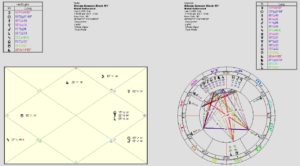 3. Bitcoin Genesis Block, January 3, 2009 at 18:15:05 UTC, in Sydney, Australia. The ascendant is ~11 degrees sidereal Sagittarius in Mula nakshatra, which is relatively close to the ascendant in the horoscope for the White Paper in Van Nuys, California. Sagittarius does in fact fit Bitcoin as you will read further on.
3. Bitcoin Genesis Block, January 3, 2009 at 18:15:05 UTC, in Sydney, Australia. The ascendant is ~11 degrees sidereal Sagittarius in Mula nakshatra, which is relatively close to the ascendant in the horoscope for the White Paper in Van Nuys, California. Sagittarius does in fact fit Bitcoin as you will read further on.
 In regard to the previous Genesis Block chart set for Australia, I am still not convinced that Craig S. Wright of Australia is Satoshi, though I also understand that this cannot be completely ruled out. Here is the astrological chart for his announcement on May 2, 2016 at 8 AM in Sydney, Australia, when he first posted in his blog that he is Satoshi.
In regard to the previous Genesis Block chart set for Australia, I am still not convinced that Craig S. Wright of Australia is Satoshi, though I also understand that this cannot be completely ruled out. Here is the astrological chart for his announcement on May 2, 2016 at 8 AM in Sydney, Australia, when he first posted in his blog that he is Satoshi.
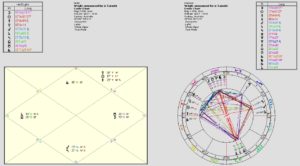 The chart for the time, date, and location of his announcement has the ruler of the Taurus ascendant chart, Venus, occupying the 12th house of privacy, feasibly pointing to a tenuous and nebulous state of affairs. Or, perhaps, I wondered, could this 12th house influence just reflect that he was “coming out of the closet” about being Satoshi? Yet, the Sun is also in the 12th house which reveals how perplexing and unconvincing Wright’s evidence would ultimately prove to be.
The chart for the time, date, and location of his announcement has the ruler of the Taurus ascendant chart, Venus, occupying the 12th house of privacy, feasibly pointing to a tenuous and nebulous state of affairs. Or, perhaps, I wondered, could this 12th house influence just reflect that he was “coming out of the closet” about being Satoshi? Yet, the Sun is also in the 12th house which reveals how perplexing and unconvincing Wright’s evidence would ultimately prove to be.
Mercury is retrograde lord of the 2nd house of speech and communications, also in the 12th house of secrecy, and at the 29th anaretic degree which reveals how the matter of Wright’s assertion would remain quite ambiguous, as he would go on to vacillate and not provide the final necessary evidence at the last hour to be able to back his claim. This confusion is all further demonstrated by the placement of Neptune conjunct the MC, pointing to Wright’s bewildering demonstration, his suspicious persona, and the way-out state of affairs that developed after his announcement.
Neptune conjunct the MC reflects how Wright’s journey to prove he was Satoshi led him and those around him into a cloud of muddled statements, paranoid behavior, untruths or half-truths, and in the end, no real final proof. All this indicates that his statement may not have been true, which seems to be the overriding conclusion of my research, though it is not definitive one way or another and we may never know.
5. Bitcoin Genesis Block in Van Nuys, CA, Jan. 3, 2009 at 10:15:05 AM. Here we have Uranus conjunct the Aquarius ascendant in Shatabisha nakshatra. Aquarius, Uranus, and Shatabisha nakshatra symbolize free thinkers and free thought; social experiments; revolutionaries; Libertarianism; science and technology; democracy and other such humanitarian groups; counterfeit or alternative currencies; and puzzles. You may recall that in my first Bitcoin article, I described how mining Bitcoin is akin to solving a puzzle. And of course, Bitcoin’s origin remains a great puzzle.
 Shatabisha nakshatra reflects the idea of protection, and this matches Bitcoin which is an alternative to sovereign currency and a safeguard of global financial security. Shatabisha is also a sign of privacy, again such as what we see around the mystery of Bitcoin’s parentage and also with the nature of cryptography and the Cypherpunks. The public is slow to adopt Bitcoin, due to a suspicious lack of understanding. This also points to Shatabisha nakshatra which is ruled by the mysterious North Node of the Moon, called Rahu in Vedic astrology.
Shatabisha nakshatra reflects the idea of protection, and this matches Bitcoin which is an alternative to sovereign currency and a safeguard of global financial security. Shatabisha is also a sign of privacy, again such as what we see around the mystery of Bitcoin’s parentage and also with the nature of cryptography and the Cypherpunks. The public is slow to adopt Bitcoin, due to a suspicious lack of understanding. This also points to Shatabisha nakshatra which is ruled by the mysterious North Node of the Moon, called Rahu in Vedic astrology.
This Shatabisha ascendant horoscope for the Genesis Block could work, but the truth is, Bitcoin was born when the White Paper was released which was 2+ months before the Genesis Block was created. The Genesis Block is more like a secondary chart which we might use in addition to the main birth chart for the White Paper. We might say that the White Paper correlates to the baby landing in the world and taking its first breath, whereas the Genesis Block represents when the baby takes its first steps. I plan to study both of these charts in my ongoing research and would encourage other interested astrologers to do the same.
6. Bitcoin’s v0.1 first software release occurred on January 8, 2009. The chart for this event might be a secondary chart to use for Bitcoin forks. The v0.1 release chart for New York at 2:27:40 PM has Taurus Rising which could fit as Taurus relates to “currency and finance.” Yet, I am not convinced that Satoshi was in New York when the software was released. I believe he was in Southern California, as previously stated. The release chart for London has Leo rising which does not fit Bitcoin. The release chart for Australia has a 29-degree Sagittarius ascendant which is in Uttara Ashadha nakshatra which can relate to scientific research but does not necessarily correspond to a currency or software.
The release chart for Van Nuys, CA has Pisces ascendant in Revati nakshatra. This fits well for Bitcoin too, as Pisces represents confidential activities, puzzles, and secrets; and as the “crypto” in cryptocurrencies refers to “secrets.” “Revati” in Sanskrit refers to “wealth,” and in mundane astrology, Revati nakshatra symbolizes “currencies.”
 As mentioned, the Bitcoin White Paper represents the decisive birth of Bitcoin in my opinion. Here are some of the most significant charts I studied as I was making this determination:
As mentioned, the Bitcoin White Paper represents the decisive birth of Bitcoin in my opinion. Here are some of the most significant charts I studied as I was making this determination:
1. White Paper, November 1, 2008 at 4:10 AM in Sydney, Australia. Virgo is the ascendant in Uttara Phalguni nakshatra. Virgo in mundane astrology represents the armed forces; agriculture and food; civil service; labor; accounting; health, medical and pharmaceuticals; clothing; charities; and animals. Uttara Phalguni represents many of the same things as Virgo, along with shipping; wealth; stocks; astronomers; PR; engineering; education; tourism; diplomacy; and commerce. This obviously is not the best overall fit for Bitcoin.
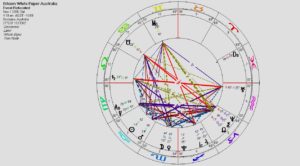 2. White Paper, October 31, 2008 at 18:10 PM in London, England. Taurus ascendant in Rohini nakshatra. Taurus signifies banks and banking; loans; finances; currencies; trade and business. Rohini represents the same as Taurus and additionally rulers; navy; judges; agriculture; automobiles; and petrol. It could work, but is not as compelling in my opinion as the Sagittarius/Mula nakshatra chart for Van Nuys (see below).
2. White Paper, October 31, 2008 at 18:10 PM in London, England. Taurus ascendant in Rohini nakshatra. Taurus signifies banks and banking; loans; finances; currencies; trade and business. Rohini represents the same as Taurus and additionally rulers; navy; judges; agriculture; automobiles; and petrol. It could work, but is not as compelling in my opinion as the Sagittarius/Mula nakshatra chart for Van Nuys (see below).
 3. White Paper, October 31, 2008 at 14:10 PM in New York City or Riviera Beach, FL (Craig Wright’s partner Dave Kleiman lived in this city in Florida). Capricorn is the sign on the ascendant, and it falls in Shravana nakshatra. Capricorn rules government institutions; land; politics; police; and big business. Shravana is the sign of rulers and public officials; shipping and fisheries; agriculture; mines and mining; petrol; geology and metallurgy; wet lands; doctors; conservatives; and wine and liquor. This is not the best fit for Bitcoin.
3. White Paper, October 31, 2008 at 14:10 PM in New York City or Riviera Beach, FL (Craig Wright’s partner Dave Kleiman lived in this city in Florida). Capricorn is the sign on the ascendant, and it falls in Shravana nakshatra. Capricorn rules government institutions; land; politics; police; and big business. Shravana is the sign of rulers and public officials; shipping and fisheries; agriculture; mines and mining; petrol; geology and metallurgy; wet lands; doctors; conservatives; and wine and liquor. This is not the best fit for Bitcoin.
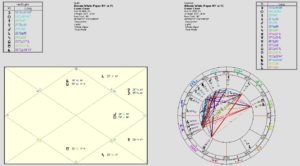 4. White Paper, October 31, 2008 at 11:10 AM in Van Nuys, CA. Sagittarius ascendant in Mula nakshatra. Bingo! First of all, as mentioned before, I believe it is likely that Satoshi was in Southern California when the White Paper was released. The chart for the release set for Van Nuys or anywhere around LA fits Bitcoin. Sagittarius ascendant represents codes, coding, and coders; commerce and banking; published academic or scientific, technological, religious, or legal papers (such as the Bitcoin White Paper); and all kinds of communication broadcasting systems including wireless networks like the Web, telephone networks, and established Internet services.
4. White Paper, October 31, 2008 at 11:10 AM in Van Nuys, CA. Sagittarius ascendant in Mula nakshatra. Bingo! First of all, as mentioned before, I believe it is likely that Satoshi was in Southern California when the White Paper was released. The chart for the release set for Van Nuys or anywhere around LA fits Bitcoin. Sagittarius ascendant represents codes, coding, and coders; commerce and banking; published academic or scientific, technological, religious, or legal papers (such as the Bitcoin White Paper); and all kinds of communication broadcasting systems including wireless networks like the Web, telephone networks, and established Internet services.
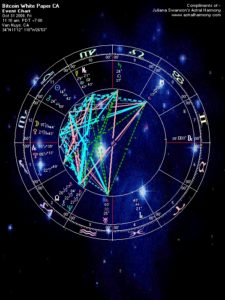

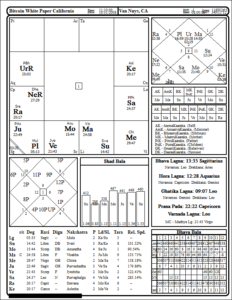 Mula nakshatra represents grand ventures, international trade, and foreign exchange. The lagnamsa (ascendant in the D9 navamsa chart which relates to what can be produced) falls in the second pada of Taurus, which has strong material implications. The ruler of Mula nakshatra is Ketu, the Moon’s South Node, which has important significance for Bitcoin and other cryptocurrencies, which I will describe in part below and in future articles, as well.
Mula nakshatra represents grand ventures, international trade, and foreign exchange. The lagnamsa (ascendant in the D9 navamsa chart which relates to what can be produced) falls in the second pada of Taurus, which has strong material implications. The ruler of Mula nakshatra is Ketu, the Moon’s South Node, which has important significance for Bitcoin and other cryptocurrencies, which I will describe in part below and in future articles, as well.
Mula’s ruler Ketu signifies a “mirage,” and this is so interesting because Berkshire Hathaway CEO Warren Buffett in the past called Bitcoin a “mirage.” He meant that he feels it is a very poor investment because it is not backed by anything. In response to this, tech heavyweight Marc Andreessen said that Bitcoin is “yet another technology that Buffett simply doesn’t understand.” (Motley Fool).
I would agree for other reasons that the term “mirage” does somewhat describe Bitcoin, but it also defines all forms of money. Andreas M. Antonopoulos, best-selling author, speaker, educator, and one of the world’s foremost Bitcoin and open blockchain experts, describes money in general as a “shared hallucination” based on a notion of value in consensus reality. In other words, it is only the collective belief of the mass mind which gives any form of money its intrinsic value. So yes, all money is a mirage.
Ketu and his counterpart Rahu, the Moon’s North Node, are chaya graha (shadow planets) and both have a mirage-like effect as they do not have physical bodies but are astronomical areas marking the intersection of the Sun’s path with the Moon’s, upon which eclipses occur. As they help to spin the whole dreamlike web of creation, they signify the powerful unconscious force that controls all karmic events. Both Ketu and Rahu are especially important in the understanding of Bitcoin and other cryptocurrencies, which I will discuss in my future articles.
Mula nakshatra embodies a power that destroys and breaks things apart (barhana shakti), just as the blockchain and cryptocurrency revolution threaten to break apart the global banking cabal and revolutionize the whole world on so many other levels. Vedic astrologer Prash Trivedi explains the power of Mula nakshatra relative to its position as the 19th among 27 nakshatras. The number 19 = 1 + 9, thus representing the alpha (1) and omega (9), and so, Mula has the power to cut away what has lost its usefulness in order to birth a new reality. (p. 311 The 27 Celestial Portals)
Mula nakshatra is located in the root or center of the Milky Way Galaxy in the home of Lord Brahma, the universal creative force manifesting through our material realm and operating through Ketu. Bitcoin and the blockchain represent a significant evolutionary development for humanity born out of this supreme transformational creative power. The late Vedic astrologer and philosopher Bepin Behari epitomized this power in his beautiful description of Ketu as the “primeval essence of manifestation… [which is]… analogous to the fire-mist which forms the basic material for the concretization of the universe.” (pp. 112-114 Myths and Symbols of Vedic Astrology)
Pluto, the planet of power, depth, money, death, rebirth, and unity through organization, is conjunct the ascendant of this Bitcoin chart. Pluto here reflects the essence of Bitcoin as a revolutionary system that mysteriously manifested out of the collective unconscious in order to transmute and advance socioeconomic conditions for all people globally while uniting them in some form. According to Co-Founder and CEO of the Neurohacker Collective Jordan Greenhall in a February 2016 article on Medium.com: “Bitcoin is a self-organizing form of collective intelligence that is so much more capable than anything in the current environment that it will sweep away even the most powerful contemporary collective intelligences (in particular both corporations and nation states) in establishing itself as the new dominant form of collective intelligence on the Earth.” This description sounds very Plutonian indeed, and further points to the impact of both Ketu and Rahu.
Probably the most compelling argument for the Sagittarius/Mula chart for Bitcoin is the close connection it has with one of the birth charts for the World Wide Web, or simply the Web, which was invented by Sir Timothy John Berners-Lee. The original birthday of the Web was in 1989, but the chart many of us astrologers use is for its public debut on August 6, 1991 in Geneva, Switzerland at 16:00:12 UTC (18:00:12 CEDT), when Berners-Lee made the Web a publicly available service on the Internet. This chart ascendant is also in Sagittarius at ~1 degree, also in Mula nakshatra.
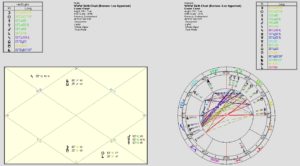 When I initially set out to find the birth chart for Bitcoin, I felt that the chart should somehow mirror this horoscope for the Web, which the Sagittarius ascendant chart does indeed. The Bitcoin White Paper ascendant is a few degrees beyond the ascendant in the Web horoscope, reflecting a progression of sorts. I felt this was important because at the most basic level, both the Web and Bitcoin/the blockchain are built into the physical system of networks known as the Internet.
When I initially set out to find the birth chart for Bitcoin, I felt that the chart should somehow mirror this horoscope for the Web, which the Sagittarius ascendant chart does indeed. The Bitcoin White Paper ascendant is a few degrees beyond the ascendant in the Web horoscope, reflecting a progression of sorts. I felt this was important because at the most basic level, both the Web and Bitcoin/the blockchain are built into the physical system of networks known as the Internet.
The Web and Bitcoin epitomize two successive evolutionary leaps in technological advancement in the field of computer science. Each connects numerous sources of information in a decentralized global network. Both are disruptive technologies; even the Web in its early days upset the status quo of existing communication providers. And, they have been similarly misunderstood, mistrusted, and mislabeled as “fads.” The Web was the first major mechanism through which information could be exchanged on the Internet. Bitcoin and the blockchain represent a remarkable advancement in the way we could organize, process, and exchange information on the Internet.
Berners-Lee himself has also stated that the “blockchain and the Web will connect together in lots of interesting ways.” I believe this is because they are like mirror images, which is also reflected in the matching ascendants of their astrology charts. Even their creation and development are mirrors, as Berners-Lee built on existing Internet technology to invent the Web, and similarly, Satoshi Nakamoto built on existing cryptographic technology (also on the Internet) to form the blockchain public ledger.
In my next article, I will analyze my Bitcoin chart in detail further verifying and validating the claims that I have presented here. Thank you to my dear friend Dr. Sisira Amarasinghe for all of his invaluable input.
Thank you to my dear friend Dr. Sisira Amarasinghe for all of his invaluable input.
I provide articles on this site and on my Astral Harmony Facebook blog as free education, and the time and energy I spend is considerable. In the past, my readers and fans have asked how they can contribute as a way of saying “thank you.” If you would like to support my work, please feel free to “Help and Support” via one of the pay buttons above (PayPal or Bitcoin). Thank you!
